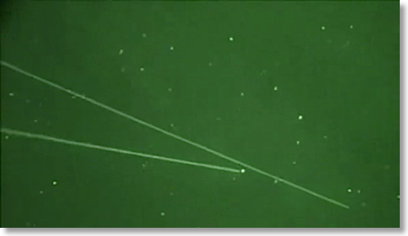Home
A comprehensive resource for safe and responsible laser use
US: Lasers used to tag UFOs?
Rose refers to YouTube clips where handheld lasers are pointed at moving dots of light in the sky.
Writes Rose:
“The idea seems to be to light up the objects with a laser pointer until they "respond" by suddenly glowing brighter. Successful attempts are met with cheering and exclamations….”
The article does note that pointing lasers at aircraft is illegal. And, if they are from another planet, aiming lasers at aliens is not smart.
Below is one of the YouTube videos referenced. Lasers are shown at 0:04-0:39, 6:55-7:03, 7:23-7:33, 7:35-7:52 (the irregular line is probably due to the rolling shutter artifact of some CMOS sensors), 8:03-8:57, and briefly at 9:00. There is a line from 5:50 to 6:25 but it appears to be a wire and not a laser.
Below is a still frame from 0:34 in the video showing two lasers; one is almost hitting an sky object while the other is tracking a second object:

Still frame from 34 seconds into the “Unbelievable Night Vision UFO Events” video.
At 9:00 in the video, a clip of a laser being aimed skyward is labeled “Dr. Steven Greer - Disclosure Project.” In a 2005 Hustler interview, Greer stated “In Pensacola, Florida, we signaled [a UFO craft] with high-powered lights and lasers -- and they signaled back to us!”
From Examiner.com and DisclosureProject.org
Commentary from LaserPointerSafety.com: Watching the video, one explanation for star-like objects moving at a constant rate is that they are satellites. The brightness increases can be due to satellite flares -- light reflecting off solar panels or other structures. For example, the well-known Iridium satellites have bright “flares” lasting a few seconds -- bright enough to be seen during the daytime. The website heavens-above.com lists predictable visibility times for Iridium and other satellites.
.